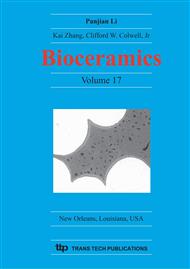p.473
p.477
p.481
p.485
p.489
p.493
p.497
p.501
p.505
Formation of Hydroxycarbonate Apatite Layer on Poly(Lactic Acid) Composites in Simulated Body Fluid
Abstract:
Hydroxycarbonate apatite (HCA), which formed on a poly(lactic acid) (PLA) composite membrane containing vaterite or calcium chloride after soaking in simulated body fluid, was examined to clarify the importance of the ceramic phases in the composites. FT-IR spectra showed that the ratio of CO3/PO4 in the infrared adsorption bands of HCA formed on the PLA composite containing vaterite was much larger than that of HCA formed on the PLA composite containing calcium chloride. Substitution of carbonate ion in hydroxyapatite is believed to be strongly influenced by ceramic phases in the composites. The zeta potentials of HCA formed on the PLA composite containing vaterite or calcium chloride was -6 mV or -17 mV, respectively. The zeta potential may be influenced by the amount of carbonate ion in hydroxyapatite.
Info:
Periodical:
Pages:
489-492
Citation:
Online since:
April 2005
Authors:
Price:
Сopyright:
© 2005 Trans Tech Publications Ltd. All Rights Reserved
Share:
Citation:


